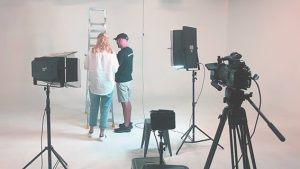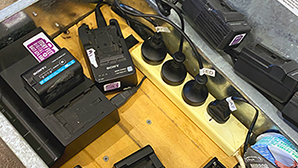A no-show or lateness
All the ducks for your shoot are in place: you’ve booked the location, prepped the gear, the weather’s come good and you’ve arrived plenty early to unpack and set up so you’re ready to record. Except your key on-camera talent – actor, interviewee – is nowhere to be seen.
It happens. And sometimes it’s not talent or actors, but the crew! Occasionally even a client.
So what can you do to reduce the risk of it happening on your watch?
- Call sheets with pertinent info – location, date, time and parking information – help furnish everyone involved in a shoot knows all the pertinent information. Send them via email with the date and subject of the shoot in the subject header for easy reference. A map is a must-have and a life saver on shoots.
- Chances are your call sheet won’t get read until the day before the shoot, but it does ensure all the pertinent information is easily accessible and in the one spot.
- Call, text or email a polite “remember our shoot” reminder to everyone involved at least 24 hours before the shoot. If you haven’t received a reply, pick up the phone to lock it in.
Tech Failure
The last thing you want on the day of a shoot is for your filming equipment to go awry and set you back.
And if you don’t charge up your camera (or phone) and check all your lighting and microphone batteries are charged, chances are on the day of the shoot they’ll let you down.
What to do to safeguard against it being the gear that messes up your shoot?
- Ensure you have the right gear for your shoot. If you’re hiring in specialist gear, collect it the day before the shoot.
- Charge all equipment the day before the shoot. Pack extra batteries, power cables and double check everything you need is packed.
- Test it all works and set up a system (say with batteries) so you can manage it all systematically and logically.
- Be sure to have more storage / memory cards than you need: anticipate a failure or an overshoot rather than assuming it won’t happen.
- If you’re shoot involves autocue, upload script into the relevant device (iPad) app and format it before hand.
- If equipment is new or unfamiliar, print out a handy how-to guide and pack it with the gear for easy troubleshooting during the shot.
Location
Whether it’s a studio setting, an office or outdoor environment, your shoot will need a location. This is not a part of filming where you can afford to “wing it”, even if you’re at an event.
So how can you secure a location and ensure it’s fit for purpose?
- A recce – reconnoitre – of a proposed location is well worth the time and effort. It will help you identify the locations suitability and work out camera and equipment layout, as well as power, lighting and backdrops ahead of the shoot date.
- Organise parking and access with the location provider and discuss any changing and toilet facilities for on-screen talent.
- If you’re planning on filming outdoors, do you have permission to film? Public areas such as parks, beaches and reserves are likely to be Council or Government owned and as such require written permission – and often a fee – for commercial filming purposes.
- If filming at an event and not directly commissioned by the event team but by an exhibitor for instance, you will need to seek their permission to film.
- For drone photography check regulatory restrictions and no fly zones: most National Parks prohibit drones without express permission and flight plans.
No wifi or phone signal (it happens!)
Can’t order lunch? Someone late but you haven’t heard from them? Need a last-minute script approval from client HQ hundreds of kilometres and a whole State away?
The thought of shoot without wifi or phone signal is virtually unimaginable but it does happen?
What do you do if you’re in a phone or wifi blackspot?
- It happens, so be sure to check in advance of your shoot whether your chosen location is one of those rare places where the inter web and phone towers doesn’t reach. Can you swap providers, get a wifi hub or some other piece of tech to support your production on set?
- If cast, crew and client are at different spots on set consider walkie talkies as a way to communicate. Old fashioned yes, but highly effective for teams on the run.
- If conditions dictate and budgets allow, employ a production runner to be the messenger on and off set.
Feed them and they will come
At Itchy Feet Digital we know our videographer Andy well enough to know that if he’s not got a fully belly he will eventually stop working. And conversely if he’s regularly caffeinated, he’ll happily power on like an energiser bunny ’til the sun goes down.
How to ensure maximum productivity and performance from everyone on set?
- Build regular breaks into the shooting schedule for everyone to take a break, hydrate and grab a snack.
- Provide plenty of water and healthy snacks on set for everyone to help themselves.
- For long shoot days or in remote locations, it pays to cater for your cast and crew on set. Not only will it see easier all ‘round but it will also save you time, as people don’t have to leave set and go exploring to find food options.
Bad conditions
Guaranteed if you’re planning a shoot outdoors, conditions are what will be most likely to scupper your shoot.
What to look out for?
- It’s good practice with any outdoor filming to monitor weather leading up to the shoot. If conditions are looking unfavourable, consider an alternative date or location. Make a call as late as you can without disrupting logistics such as travel and catering for cast and crew.
- Whilst you can’t control the weather you can adapt filming to accommodate. If it’s wet and windy, do you have an indoor alternative or at worst a structure to stop talent and equipment getting wet?
- If you have to carry on filming in spite of the weather, consider what equipment and resources you can provide to make it easier to bear. Rain covers for cameras, waterproof clothing, spare towels, hot drinks on tap, plenty of water and snacks, even sun cream can make a bad shoot feel slightly better. And never leave home without a first aid kit and the address of the local hospital: just in case.
Poor on-screen performance
You’ve put a heap of time, money and effort into ensuring your idea is awesome and your shoot will bring it to life, but the people you’ve enlisted to be on camera just aren’t up to scratch.
But rather than scrapping the shoot, wouldn’t it be good instead to avoid that scenario?
How do you get the best from your on-screen talent?
- Connecting with your talent before your shoot whether in person or on the phone is a valuable use of time. Not only does it enable you to directly converse with them about the project and their role, but it’s also a relationship building exercise that will also save you briefing and introductory time on set. It’s also a good opportunity to reiterate the project end goals, publishing and importantly to talk about what they should wear, the shooting schedule and how they can best prepare.
- If you’ll be interviewing them on camera, talking to them about the topic is also valuable research that will help you identify what elements will be useful to record on camera. Better still it gives you an idea of their confidence and ability to converse on the topic. If you’re hesitant about their suitability it gives you time to extend shooting time or potentially to replace them.
- Encourage the talent to prepare in advance. Provide them with a list of questions so they can consider their answers before hand, noting that rote learning may sound wooden anda inauthentic on camera: it’s a delicate balance.
- For actors delivering scripted dialogue, ensure they have sighted the script well in advance and know what will be required of them on the day in terms of delivery, accent, tone and character. You may nee to organise a face to face rehearsal with DOP and director beforehand or an on-line read through may be sufficient.
- Arriving late, struggling to find a park, being thrown a new set of last-minute script changes are all elements that can add to the stress and anxiety of being on camera. Support your talent as much as possible with clear directions to the set, on-site parking and organised production management so they can concentrate on the best delivery possible.
- On the day of filming, keep personnel to a minimum and ensure everyone is focused on the outcome. The last thing a nervous interviewee or new actor needs is a cast of thousands critiquing their performance beg=hind the camera or even worse gossiping and distracting them.
- A stressed producer, impatient director or a grumpy camera operator can also contribute to poor performance. Ensure your crew are
- If you’re a client, try and avoid taking over during filming. Work out an approach that suits you and your team, remembering that sometimes directing talent or offering conflicting critique to your crew, can be confusing and demoralising to those appearing.
- Being on camera raises the body temperature: the combination of camera lights and discomfort can make those appearing on camera incredibly hot, thirsty and irritable. Provide plenty of drinking water and healthy energy-inducing snacks to keep everyone pumped and on point!
The legal stuff
For anyone filming for commercial purposes, there are a heap of regulatory requirements aimed at protecting people, property and your business.
Most scenarios are unlikely to happen, but the implications of dealing with problems arising from legal / regulatory non-compliance are serious, so it’s well worth mitigating the risk by doing the right thing.
How do you ensure you are legally compliant?
- Anyone featuring in a video (for broadcast or commercial purposes) needs to have given their written consent to be filmed. Contributor Release Forms – paper or digital versions – help collate all contact details and signatures from contributors as well as given them formal identification of the video organisation and where it will be published.
- If you are filming in a public place, technically anyone who doesn’t feature in your video (eg who’s in the background or relatively unidentifiable) doesn’t need to consent. However we recommend using common courtesy and let people know what is going on and the implications of being in involved.
- For filming in public Council owned spaces, seek written permission via email or better still a signed Location Release Form.
- With any endeavour that creates risk to crew, cast and members of the public, you will need to have Public Libabity Insurance. Most venue will need to sight this before giving you permission to film. PLI covers you for accidental damage, injury or death to anyone directly or indirectly involved in filming.
- Rather than relying on this, ensure any equipment or props used in your video shoot are safely constructed, stored and used, weight down stands with sandbags, tape over cables across access ways and.
- If drone footage is part of your shoot, the last thing you want is for that drone to fall out of the sky and cause injury or to interrupt aircraft flights. Operators using drones weighing more than 2kgs need to have completed a safety flying course through CASA (Civil Aviation Safety Authority) and submit flight plans for their filming. Even those operators flying lightweight drones for commercial purposes must be registered and have accreditation before flying.
If in doubt – be prepared
As with any project, the key to success is to be as prepared as you can and anticipate any potential problems in advance.
Anticipate the unexpected, prepare for every eventuality and even if you something surprising and unexpected happens, deal with it calmly, professionally and quickly.
The more shoots you do, the more organised you will become. And with organisation comes confidence and a deeper enjoyment of the process.
Good luck!







